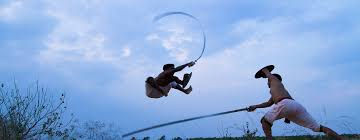South Asian Martial Arts: Shastra Vidya/Gatka
- Amir Hamza
- Jul 13, 2020
- 4 min read
Heading over to the big guy, quite literally. We are in India. Specifically the North West state of Punjab. Whilst the historical Punjab is split between Pakistan and India. The modern day Punjabi community is known for their loud and boisterous personalities. Love of music and proud warrior culture too. It is no wonder they have their own style of martial arts befitting their size. Here we look at Shastra Vidya and its modern counterpart Gatka.

Martial Art: Shastra Vidya/Gatka
Style: Striking/Weaponry
Country: India
Origin: Punjab
History: Shastra Vidya is a Punjabi martial art which translates to Science of Weapons. It's modernised counter part Gatka is derived from the Sanskrit word Gada meaning "Mace" a type of club. Before the art was associated with the Punjabi Sikhs, their ancestors were devotees to Shiva called the Pushapatas who were developing the earliest combat technique which grew into Shastra Vidya. They were believed to have existed between the 1st century to 4th century CE. The Pushapatas also carried Clubs in resemblance to one of their deities called Lakulisha. The clubs were simple but common weapons at the time and it is understandably the art adapts to add the Gada mace among many bladed weaponry. It was after the 10th century did the art become a prominent style for Hindu, Muslims and Buddhist in the Punjab region and then into the 15th century with the rise of Sikhism did the style become renamed Gatka with the Punjabi Sikhs legendary ventures. Around the 19th century after the anglo-sikh wars the martial arts practice for the Punjabis was banned. After the Sikhs assisted the British against the Indian Rebellion in 1857 did the British allow their Punjabi soldiers to practice the art with sword being replaced with sticks or clubs for practice.

Culture: The basis of Shatra Vidya involves a 3 principles. The first principle is Locomotion, which is achieved by maintain ones mass over their centre of gravity. Then, by Dolana (spilling) one's centre of gravity in the desired direction, one attains motion as the feet follow in a measured step. In order to alter direction, one of the limbs, the head or any other part, is subtly jolted out and employed as a counter balance in mid movement. This extremely subtle spilling skill allows for far greater smoothness, agility and swiftness of movement. The second principle is Angling. Instead of angling at forty five degrees (as many martial arts do), Shastar Vidiya's narrow foot base, enables a much sharper cutting of angles. The footwork too possesses a feature whereby one foot is off the ground during the spilling motions. The third principle is generating power. Rather than employing muscular power, solid structures, or firm grounding to generate power, it is actually generated through movement. Shastar Vidiya's power generation is achieved by an ever-flowing fluid manner by sinking one's body mass through every grab, hold, strike and cut whilst driving through with the body's kinetic energy.
Warrior: Typically many Shastar Vidya warriors will wear Dastars/Turbans, which are obligatory for male Sikhs. For Women practitioners this is not requirement. However it is common for many warriors to wear loose fitted cholas, a kind of long shirt. Alongside this they would also wear either loose trousers or shorts. There are many styles or Yudhans associated with mostly animals or deities that includes Viraha Yudhan (Boar style, uses heavy clubs and close quarter combat), Sheshnaga Yudhan (Snake style, uses scarves, blades and slipping techniques to strike marmans/vital points or joint manipulation), Garua Yudhan (Bird style, uses dual wielding weapons of any combination and uses hit and run tactics similar to outboxing), Nandi Yudhan (Bull style, uses curved blades and grappling or low blows to ground an opponent), Narsingha Yudhan (Tiger Style, uses heavy armour, shields and long handled axes, targets the head or neck for a quick kill), Hanuman Yudhan (Monkey style, similar to Narsingha but prefers a lower stance to attack legs, groin and lower body), Bagh Yudhan (Leopard style, uses knuckle duster weapons like Bagh Naka or Katar and trains in Loh-Musti meaning "Iron Fist" referring to Bone conditioning) among others.

Media/Potential: Many Shastra Vidya or Gatka performers have brought this culture of Punjabi martial arts to the mainstream media mostly through Khalsa group performances. Many of these performances have involved Khalsa group appearing on Talent shows to flex their impressive pain tolerance and resistance whether it involved bending metal sword against their skin or crushing glass with a bite. They tend to take their performances to the extreme. Notably however a signature weapon of the styles called a Katar was used as the default starter weapon for the Martial Arts character design in DC Universe Online. It is very possible for a fighting game to establish a Punjabi Sikh character into a game and just for exaggeration, can have them stand at 7'6" like Bir Khalsa's very own Jagdeep Singh who is notoriously known for being the whole tallest police officer alive. I mean have you seen the size of Street Fighter's Abigail and Tekken's Fahkumram. Why not introduce a gigantic Pubjabi in the same vein as there two characters. Even more Jagdeep Singh is a polcie officer so imagine a fighting game character having this kind of character square up to them?



Comments